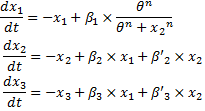Team:Paris/Modeling/BOB/Akaike
From 2008.igem.org
(Difference between revisions)
| Line 16: | Line 16: | ||
[[Image:syste_akaike_1.jpg|center]]<br> | [[Image:syste_akaike_1.jpg|center]]<br> | ||
'''System#2''' : using classical Hill functions :<br> | '''System#2''' : using classical Hill functions :<br> | ||
| - | [[Image: | + | [[Image:syste_akaike_2_bis.jpg|center]]<br> |
* We made a set of data out of a noised Hill function. In fact, our data set was made by using the same equations as System#2, but we introduced a normal noise for each point. Thus, System#1 is penalized because its RSS will be greater than that of System#2. Nevertheless, System#2 will be more penalized by its number of parameters. | * We made a set of data out of a noised Hill function. In fact, our data set was made by using the same equations as System#2, but we introduced a normal noise for each point. Thus, System#1 is penalized because its RSS will be greater than that of System#2. Nevertheless, System#2 will be more penalized by its number of parameters. | ||
Revision as of 12:46, 3 September 2008
|
(Under Construction) Model Comparison
where n denotes the number of experimental values, k the number of parameters and RSS the residual sum of squares. The best fitting model is the one for which those criteria are minimized.
System#1 : using the linear equations from our BOB approach : System#2 : using classical Hill functions :
We mostly used the definition of the criteria given in : [http://www.liebertonline.com/doi/pdf/10.1089/rej.2006.9.324 K. Kikkawa.Statistical issue of regression analysis on development of an age predictive equation. Rejuvenation research, Volume 9, n°2, 2006.] |
 "
"


